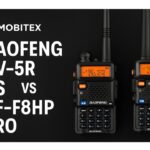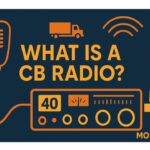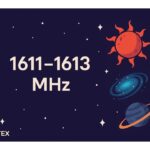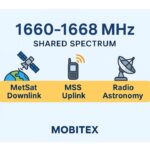Frequency
1129 MHz
Range
960–1215 MHz
Band Group
L-Band Aeronautical Radionavigation (960–1215 MHz)
🌐 Summary
The 1129 MHz allocation is part of the L-Band Aeronautical Radionavigation (960–1215 MHz) spectrum. This range is used worldwide for critical applications that keep our communications and infrastructure running smoothly. On this page we highlight how each band is applied in real systems, from regulatory assignments to everyday devices. Our goal is to make spectrum data clear and practical for engineers, regulators, and enthusiasts alike.
Key uses of this band include: This band is globally used for aircraft navigation, radar, DME, SSR, ADS-B, and Mode S systems. It ensures safe aircraft positioning and collision avoidance, coordinated internationally under ICAO and ITU RR 5.328A..
Global aviation navigation & surveillance; collision avoidance; strict protection
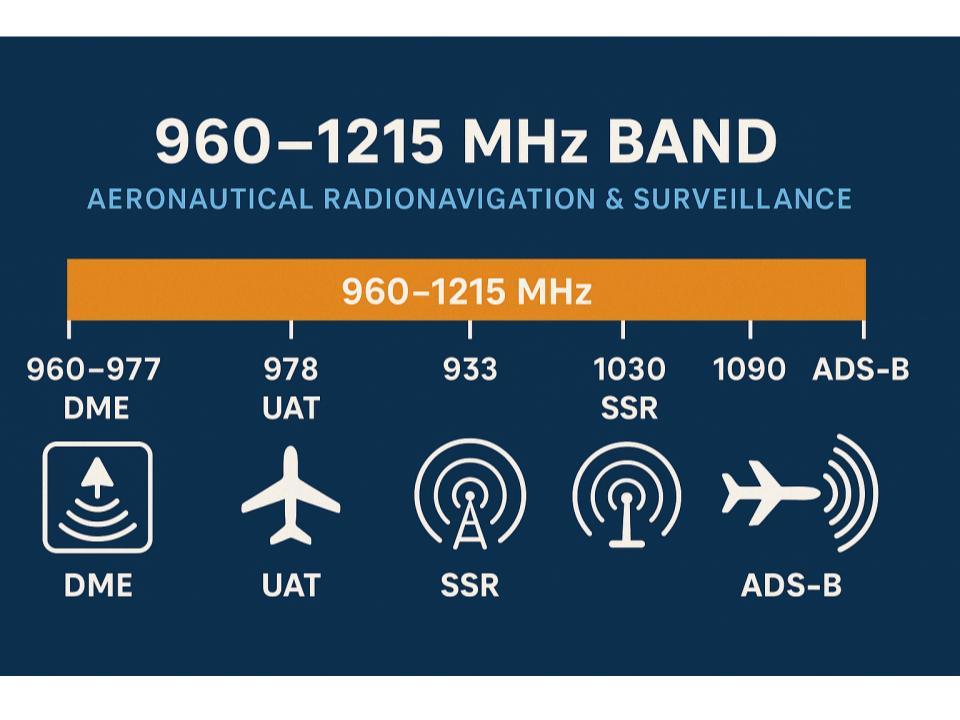
🔍 Explore the full RF Spectrum database
📡 Band & Geometry key
| Field | Value |
|---|---|
| Wavelength (m) | 0.265538 |
| Waveforms | Pulse-based waveforms (DME, SSR, ADS-B, Mode S) |
| Antenna Form Factor (Typical) | ¼-wave ≈ 7 cm |
| Band Family | Aeronautical / L-Band Navigation |
| Band | 960–1215 MHz Aeronautical Radionavigation & Surveillance (ARNS) |
| Primary Common Name | Aeronautical Radionavigation (DME/TACAN/SSR/ADS‑B vicinity) |
| FSPL @ 1 km [dB] | 93.49 |
| FSPL @ 10 km [dB] | 113.49 |
| Fresnel Radius @ 1 km (m) | 8.148 |
| Band Group | L-Band Aeronautical Radionavigation (960–1215 MHz) |
| Tax Band Family | UHF/L-band Transition |
| Tax Band Class | 960 MHz – 1215 MHz UHF/L-band Transition |
🧩 Applications & Usage
| Field | Value |
|---|---|
| Primary Application | Aircraft navigation and landing systems |
| Lower Neighbor Use | 960 MHz – Start of Aeronautical Radionavigation band |
| Upper Neighbor Use | 1215 MHz – Transition to Aeronautical Radionavigation and Secondary Radar |
| Typical Services Devices | DME transponders, airborne radar altimeters, SSR/ADS-B transceivers |
| Market Common Devices | Aircraft transponders, radar altimeters, and ground radar beacons |
| Refarming Use | Not applicable (protected aviation allocation) |
| Device Ecosystem Size | No coexistence with commercial mobile services; protected aviation use only |
| Device Hotspots (MHz) | Spectrum sharing limited to coordinated aviation systems only |
| Device Category | Aviation Navigation and Surveillance Equipment |
| Typical Use Cases | Distance measurement (DME), secondary surveillance (SSR/Mode S), ADS‑B surveillance, TACAN |
| Modulation (Device) | Pulse‑pair and reply code formats per ICAO Annex 10 |
| Channel Width (Device) [kHz] | 1 MHz nominal (SSR/Mode S); DME channelization |
| Device Region Profiles | Global (harmonized under ICAO/ITU) |
| Per-Region EIRP Or Duty (Device) | Ground up to ~60 dBm ERP; airborne ~20–30 dBm; duty per system spec |
| Allocation Relevance (Device) | Primary aviation allocation — mandatory for certified avionics |
| Adjacent-Band Collision Risks (Device) | Low; guard bands below 960 MHz and above 1215 MHz; strict protection |
| Example Devices Or Skus | Honeywell DME 990; Garmin GTX 335/345; Collins Mode S |
| Common Protocols | DME, SSR, ADS-B, Mode S, TACAN |
🗒️ Notes
| Field | Value |
|---|---|
| Receiver Selectivity Notes | High selectivity required to mitigate interference from adjacent radar channels |
| Interference Notes | Protected globally; interference strictly managed via ICAO coordination |
| Compatibility Risk Notes | Minimal coexistence risk; strict separation from adjacent mobile and satellite bands |
| Notes | Global aviation navigation & surveillance; collision avoidance; strict protection |
| Propagation Notes | Line-of-sight L-band; minimal diffraction; performance improves with altitude |
⚙️ Technical Rules
| Field | Value |
|---|---|
| Lower Band Frequency Limit | 960 |
| Upper Band Frequency Limit | 1215 |
| EIRP Indoor Limits | N/A (not applicable to aeronautical systems) |
| EIRP Outdoor Limits | Typically +50 dBm to +60 dBm (high power transmitters) |
| PSD Limit | Not standardized (depends on aircraft equipment) |
| Emission Mask Class | Strict aviation-specific emission mask (ICAO Annex 10) |
| Guardband Minimum [kHz] | 1000 kHz typical spacing between adjacent channels |
| Typical Bandwidths | 25 kHz (legacy) to 1 MHz (modern systems) |
| Autocalculated Bandlimits | 960–1215 MHz (Aeronautical Radionavigation, ITU RR 5.328A) |
| Typical Bandwidths (Estimated) | 25 kHz (legacy) to 1 MHz (modern systems) |
| Max EIRP [dBm] | Ground up to ~60 dBm ERP; airborne ~20–30 dBm; duty per system spec |
| Power Source Or Duty Profile (Typical) | Continuous operation; aircraft 28 VDC bus; ground AC mains with UPS redundancy |
| Channelization Plan | No commercial reallocation planned; fully reserved for aviation safety services |
| Channelization | 25 kHz, 50 kHz, or 1 MHz spacing typical for radar and DME |
| Guard Band Requirement | ICAO and ITU-R govern coordination and channel assignments |
| OOB Emission Limit [dBm/MHz] | Strict limits per ICAO/ITU standards for adjacent band protection |
| Spurious Emission Limit (dBm) | Below −47 dBm typical per ICAO/ITU standards |
| RX Blocking Min [dBm] | -10 dBm typical receiver blocking threshold |
| Duplexing | N/A (single frequency operation) |
| Duplexing Information | Simplex operation; independent transmit/receive frequencies not used |
| Uplink Pairing | Not applicable (simplex operation in aeronautical navigation) |
| Downlink Pairing | Not applicable (simplex operation) |
| Paired Band Info | None – operates independently per channel |
| Max EIRP [dBm] | High reliability, low latency pulse-based systems; operational for decades |
| Channelization Block Size | 25 kHz or 1 MHz depending on system (DME / SSR) |
| 3GPP Band Number | |
| Example 3GPP Bands | N/A (Aviation-specific band outside 3GPP scope) |
| LTE Uplink Bands | None – Aviation use only |
| LTE Downlink Bands | None – Aviation use only |
| NR Uplink Bands | None – Aviation use only |
| NR Downlink Bands | None – Aviation use only |
| Guard Bands | 1000 kHz typical between systems for interference protection |
| Protocol Or Standard | ICAO Annex 10 (DME, SSR, Mode S, ADS‑B); ITU RR 5.328A |
🌎 Country Overrides
| Field | Value |
|---|---|
| Tax Service Category | Aeronautical Radionavigation / Surveillance |
| Tax License Type | Licensed / Aviation & Defense |
| Tax Regions | Global (ITU Allocated) |
| ITU Region 1 (Europe, Africa, Middle East (west of Persian Gulf), Western Russia & Mongolia) | Aeronautical Radionavigation / Radio Altimeter / DME |
| ITU Region 2 (North America, South America, Central America, Caribbean, Greenland, Eastern Pacific Islands (Americas region)) | Aeronautical Radionavigation / Radio Altimeter / DME |
| ITU Region 3 (Asia, Australia, Pacific Islands, Oceania, Indian Subcontinent, East Asia & Southeast Asia) | Aeronautical Radionavigation / Radio Altimeter / DME |
| License Type | Aeronautical |
| Primary Application | Aircraft navigation and landing systems |
| Primary Services | Aeronautical radionavigation, DME, and radar altimeter systems |
| Spurious Emission [dBm] | Below −47 dBm typical per ICAO/ITU standards |
| Lower Neighbor Use | 960 MHz – Start of Aeronautical Radionavigation band |
| Upper Neighbor Use | 1215 MHz – Transition to Aeronautical Radionavigation and Secondary Radar |
| Licensing Model | International aviation allocation – coordinated under ICAO and ITU |
| Typical Services Devices | DME transponders, airborne radar altimeters, SSR/ADS-B transceivers |
| US FCC Alloc | Aeronautical Radionavigation (47 CFR §87.173)– |
| CA IC Alloc | Aeronautical Radionavigation Service – IC Table 5.328A (Canada)– |
| UK Ofcom Alloc | Aeronautical Radionavigation – Ofcom UK Table of Frequency Allocations– |
| US Ref | FCC Part 87 (Aviation Services) |
| Typical Bandwidths | 25 kHz (legacy) to 1 MHz (modern systems) |
| Market Licensing Model | Globally harmonized; no commercial licensing |
| Market Common Devices | Aircraft transponders, radar altimeters, and ground radar beacons |
| Fresnel Radius (1st, 1 km) [m] | 8.148 |
| Typical Bandwidths (Estimated) | 25 kHz (legacy) to 1 MHz (modern systems) |
| Auction Status | Not applicable (safety-of-life; not auctioned) |
| Refarming Use | Not applicable (protected aviation allocation) |
| Typical Site Spacing km | 50 / 150 |
| Device Ecosystem Size | No coexistence with commercial mobile services; protected aviation use only |
| Traffic Load Share | Used continuously for DME/SSR ground stations and aircraft transponders |
| Device Hotspots (MHz) | Spectrum sharing limited to coordinated aviation systems only |
| Device Category | Aviation Navigation and Surveillance Equipment |
| Typical Use Cases | Distance measurement (DME), secondary surveillance (SSR/Mode S), ADS‑B surveillance, TACAN |
| Typical Center Frequencies [MHz] | Within 960–1215 MHz L‑band; channelized per DME/SSR plans |
| Rule Part (Fcc Or Region) | FCC Part 87 (US); national aviation regs elsewhere |
| Modulation (Device) | Pulse‑pair and reply code formats per ICAO Annex 10 |
| Channel Width (Device) [kHz] | 1 MHz nominal (SSR/Mode S); DME channelization |
| Device Region Profiles | Global (harmonized under ICAO/ITU) |
| Per-Region EIRP Or Duty (Device) | Ground up to ~60 dBm ERP; airborne ~20–30 dBm; duty per system spec |
| Allocation Relevance (Device) | Primary aviation allocation — mandatory for certified avionics |
| Adjacent-Band Collision Risks (Device) | Low; guard bands below 960 MHz and above 1215 MHz; strict protection |
| Example Devices Or Skus | Honeywell DME 990; Garmin GTX 335/345; Collins Mode S |
| Antenna Form Factor (Typical) | ¼-wave ≈ 7 cm |
| Power Source Or Duty Profile (Typical) | Continuous operation; aircraft 28 VDC bus; ground AC mains with UPS redundancy |
🛡️ Regulatory & Neighbors
| Field | Value |
|---|---|
| Lower Band Frequency Limit | 960 |
| Upper Band Frequency Limit | 1215 |
| Rx Blocking Min dBm | -10 dBm typical receiver blocking threshold |
| Lower Neighbor Use | 960 MHz – Start of Aeronautical Radionavigation band |
| Upper Neighbor Use | 1215 MHz – Transition to Aeronautical Radionavigation and Secondary Radar |
| Lower Neighbor Band | Upper Mobile/Fixed allocations below 960 MHz |
| Lower Neighbor Range | 890–960 MHz (GSM 900 / LTE Band 8 uplinks) |
| Upper Neighbor Label | |
| Upper Neighbor Range | |
| Adjacent-Band Collision Risks (Device) | Low; guard bands below 960 MHz and above 1215 MHz; strict protection |
| Real-World Range (Indoor/Outdoor) | 370 |
| US FCC Alloc | Aeronautical Radionavigation (47 CFR §87.173)Aeronautical Radionavigation (47 CFR §87.173) |
| CA IC Alloc | Aeronautical Radionavigation Service – IC Table 5.328A (Canada)Aeronautical Radionavigation Service – IC Table 5.328A (Canada) |
| UK Ofcom Alloc | Aeronautical Radionavigation – Ofcom UK Table of Frequency AllocationsAeronautical Radionavigation – Ofcom UK Table of Frequency Allocations |
| Regulatory References | US: FCC Part 87 (Aviation Services); CA: Innovation, Science and Economic Development Canada – Table 5.328A; UK: Ofcom Frequency Allocation Table – Aeronautical Radionavigation |
| Global Harmonization | High (ITU RR 5.328A aviation allocation worldwide) |
| Crossborder Coordination | Mandatory via ICAO regional planning and bilateral agreements |
| Sharing Mechanism | Compliance mandatory with ICAO Annex 10 and ITU RR Article 5.328A |
| Auction Status | Not applicable (safety-of-life; not auctioned) |
| Guard Or Pair | Guard bands maintained to prevent interference between aviation systems |
📈 Market & Measurements
| Field | Value |
|---|---|
| Noise Floor | Approximately -110 dBm typical in aviation spectrum environments |
| Interference Cases | Potential interference from nearby radar and transponder systems |
| Lower Neighbor Range | 890–960 MHz (GSM 900 / LTE Band 8 uplinks) |
| Upper Neighbor Range | |
| Interference Notes | Protected globally; interference strictly managed via ICAO coordination |
| Market Licensing Model | Globally harmonized; no commercial licensing |
| Market Commercial Value | Non-commercial safety-of-life allocation |
| Market Common Devices | Aircraft transponders, radar altimeters, and ground radar beacons |
| Market Deployment Density | High in controlled airspace, sparse in general aviation zones |
| Noise Floor (Estimated) | Approximately -110 dBm typical in aviation spectrum environments |
| Market Commercial Value (Estimated) | Non-commercial safety-of-life allocation |
| Ecosystem Maturity | Very mature (decades of global deployment and certification) |
| Indoor Penetration | Not relevant; airborne/ground line-of-sight systems |
| Known Interference | Limited to air and ground-based radar/DME/SSR infrastructure |
| Device Ecosystem Size | No coexistence with commercial mobile services; protected aviation use only |
| Real-World Range (Indoor/Outdoor) | 370 |
| Antenna Form Factor (Typical) | ¼-wave ≈ 7 cm |
| Ecosystem Maturity | Very mature (decades of global deployment and certification) |
| Device Ecosystem Size | No coexistence with commercial mobile services; protected aviation use only |
| Chipset Availability | Globally protected under ITU RR 5.328A and ICAO Annex 10 coordination |
| Operator Deployments | High signal integrity; time-critical for navigation and surveillance |
| Technology Generations Deployed | Separation maintained from 900 MHz GSM/LTE and 1240+ MHz radar services |
| Roaming Support | No reallocation planned; essential safety-of-life spectrum |
| Traffic Load Share | Used continuously for DME/SSR ground stations and aircraft transponders |
| Indoor Penetration | Not relevant; airborne/ground line-of-sight systems |
| Known Interference | Limited to air and ground-based radar/DME/SSR infrastructure |
| Occupancy | Moderate to high in active flight zones; low elsewhere |
| Occupancy Bucket Pct | 60–80% (depends on flight density/airspace) |
| Latency Profile | Strong frequency protection; minimal adjacent service overlap |
| Common Channels Or Profiles | DME/TACAN channels; SSR Mode A/C/S; ADS‑B 1090 MHz (ES) |
| Security Features | Safety‑of‑life protections; authenticated ATC procedures; spectrum protection via ICAO/ITU coordination |
| Lbt Or Fhss Requirement | Not applicable; time‑slot/pulse‑based interrogate/reply systems |
| Popularity (Installed Base) | >100,000 aircraft equipped globally; commercial fleets standard |
| Coexistence Tips | Maintain strict frequency coordination; avoid interference with mobile <960 MHz and radar >1215 MHz |
| Latency Class | Ultra-low (<10 ms interrogation–reply) |
| Device Hotspots (Scoped && Tagged) | Airport vicinities, ATC centers, high-density approach/departure corridors |
